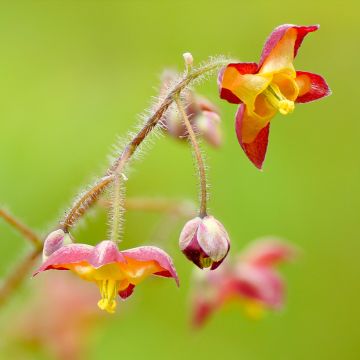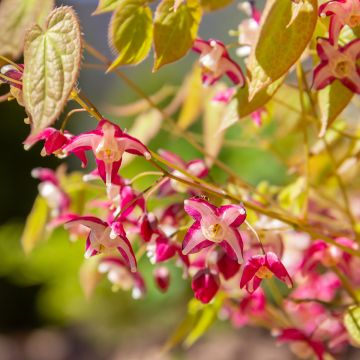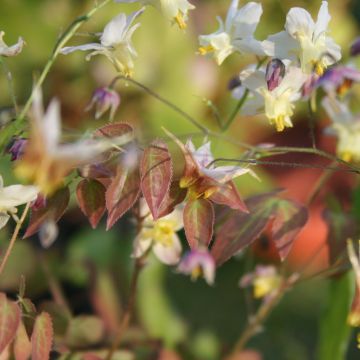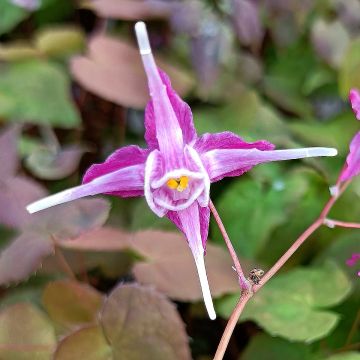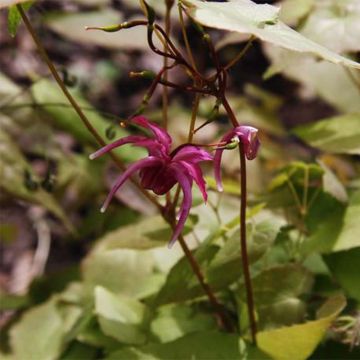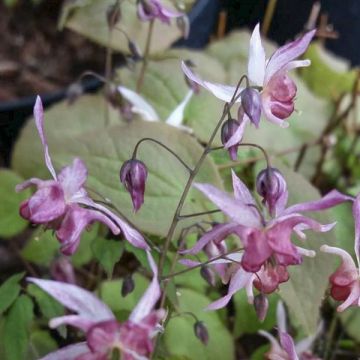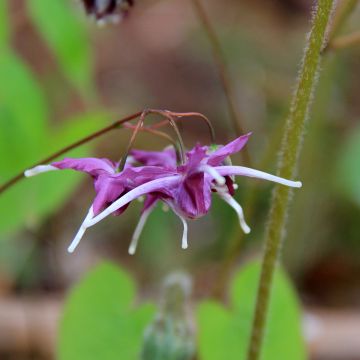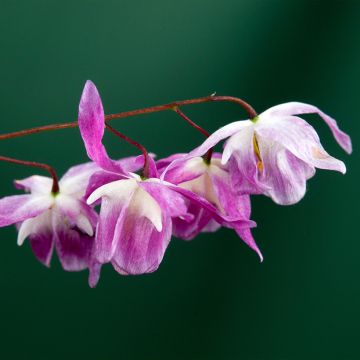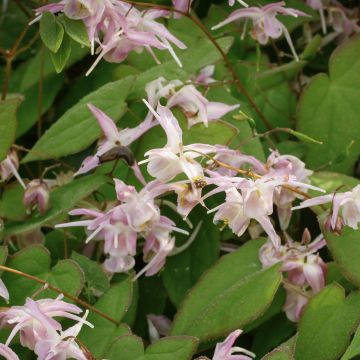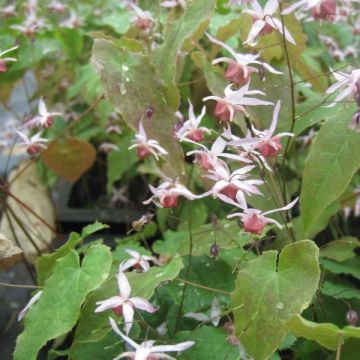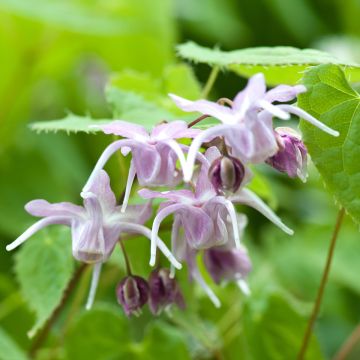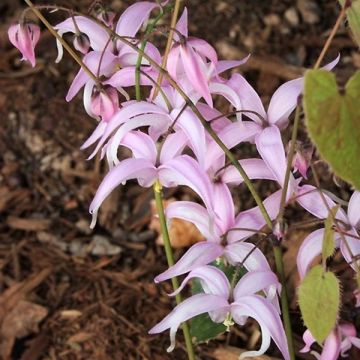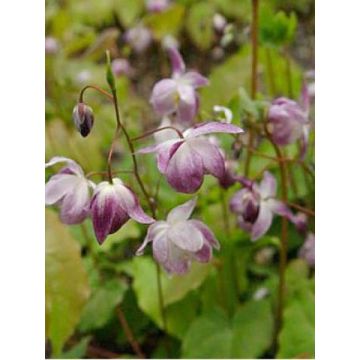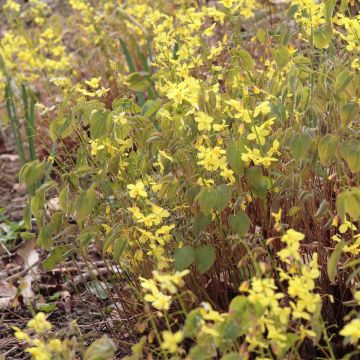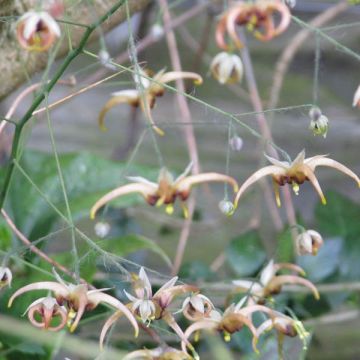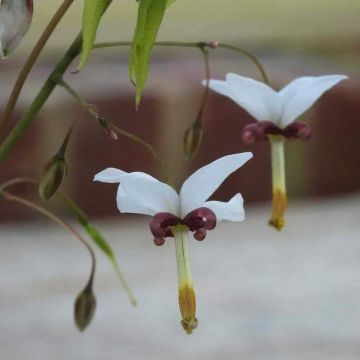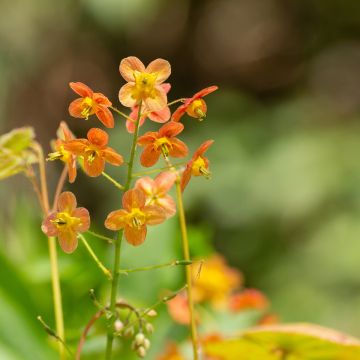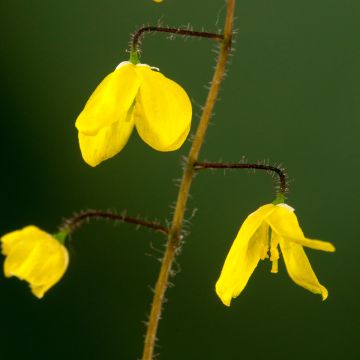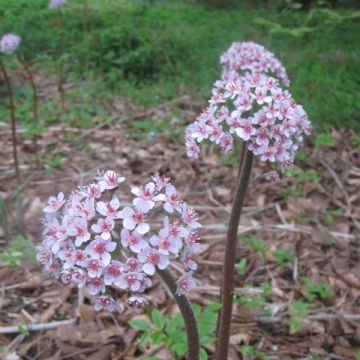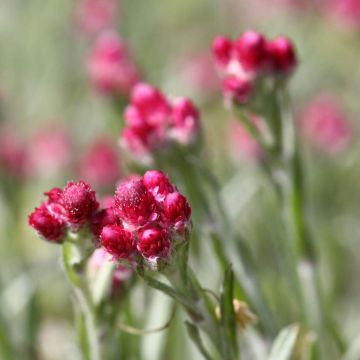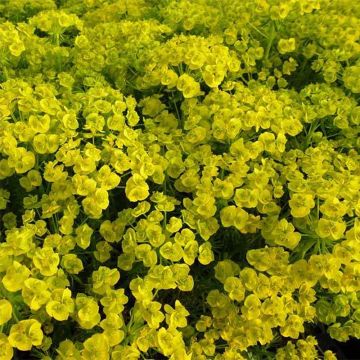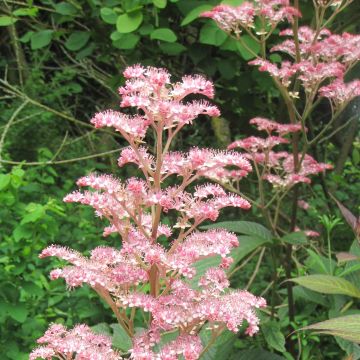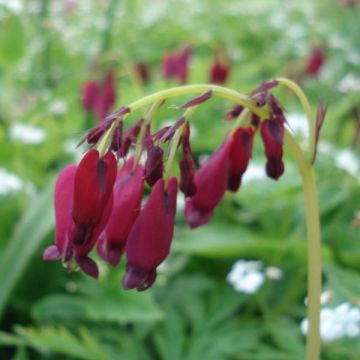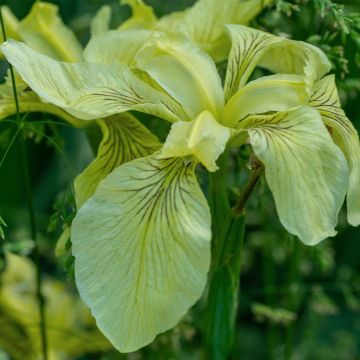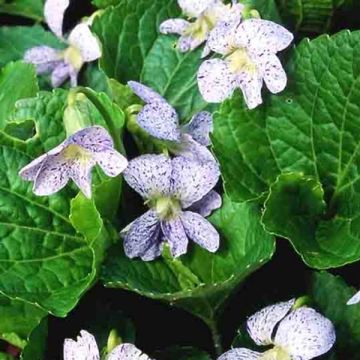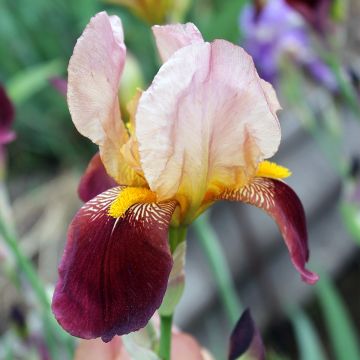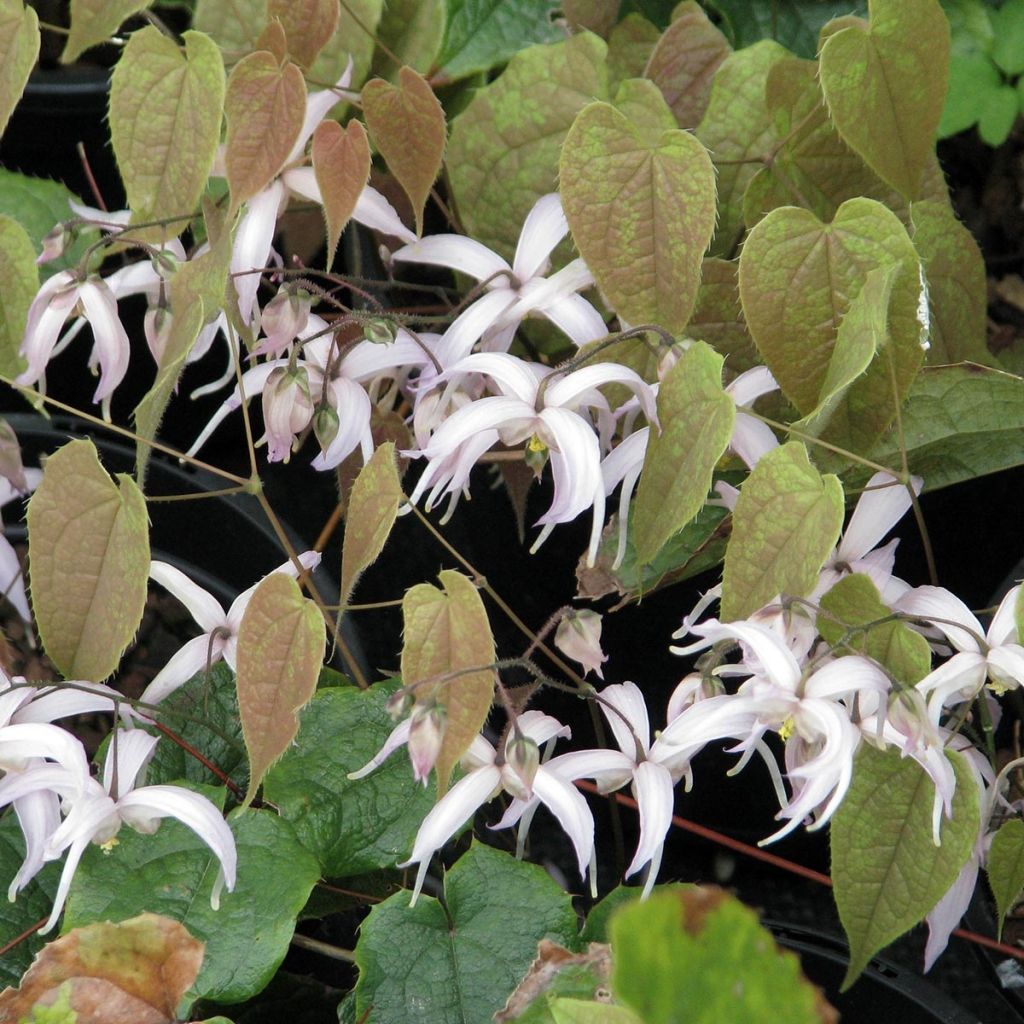

Epimedium leptorrhizum - Fleurs des Elfes
Epimedium leptorrhizum - Barrenwort
Epimedium leptorrhizum
Barrenwort
Received in February 2022. Has 2 shoots ready to start. It completes my collection of epimediums that grow very well in the PACA region.
Viviane, 01/03/2022
Why not try an alternative variety in stock?
View all →This plant carries a 12 months recovery warranty
More information
We guarantee the quality of our plants for a full growing cycle, and will replace at our expense any plant that fails to recover under normal climatic and planting conditions.
From €5.90 for pickup delivery and €6.90 for home delivery
Express home delivery from €8.90.
Does this plant fit my garden?
Set up your Plantfit profile →
Description
Epimedium leptorrhizum is quite charming and easy to grow in partial shade in any soil that is not too chalky or too dry. This perennial is very hardy and slowly spreads on the ground, forming a beautiful carpet of delicately pink-flowered leaves in springtime. Its coppery juvenile leaves unfold into large glaucous heart-shaped leaves that serve as a backdrop for lovely almost translucent pendulous flowers, among the largest found in Epimediums. Attractive all year round and undemanding, it is an elegant groundcover at the feet of trees and shrubs.
Belonging to the family Berberidaceae, Epimedium leptorrhizum is native to the Chinese provinces of Guizhou and Sichuan, where it grows in woodlands, thickets, and forest edges. This species resembles Epimedium brachyrrhizum, but it is shorter. It is a non-invasive, long and creeping rhizome plant. It sometimes takes a little time to establish itself, but eventually forms a beautiful evergreen carpet that measures about 20-23 cm (8-9in) in height and 40-50 cm (16-20in) in spread. Flowering takes place in spring, usually in April. Short floral panicles emerge from the carpet of leaves, rising 35 cm (14in) above the ground. Each carries several flowers measuring 4 to 5 cm (2in) in diameter. Each flower, hanging towards the ground, is composed of inner sepals and pale lavender pink petals that are much longer and sometimes slightly violet-tinged spurs. These flowers are perched on slender stems. Its foliage is evergreen in winter. It consists of large leaves divided into three pointed leaflets with a leathery texture, slightly corrugated and quite rough. These are an elongated heart-shape and finely toothed along the edges. They are initially beautifully coloured in subtle rusty brown, then turn bluish green.
Epimeduim thrives in shady to semi-shady conditions and tolerates root competition from other plants, making it suitable for planting at the base of trees and bushes. As a woodland plant, it tolerates some sunlight and is hardy to at least -15°C (5°F). Epimedium leptorrhizum is a good plant for effectively covering and flowering in difficult areas, but it would be a shame to confine it to a utilitarian ground cover role: accompanied by liverworts, Hellebores, Ferns, Cyclamen, Foxgloves, Euphorbias, and sweet woodruff, it will compose a superb lightly shaded border.
Report an error about the product description
Flowering
Foliage
Plant habit
Botanical data
Epimedium
leptorrhizum
Berberidaceae
Barrenwort
China
Other Epimedium - Barrenwort
Planting and care
Epimedium leptorrhizum settles in semi-shade or not too dense shade, ideally in a soil with a neutral pH (neither too acidic nor too calcareous), loose and well prepared.
It particularly appreciates humus-rich soils, so an annual compost addition will be welcome. However, this plant adapts easily to any type of ordinary soil enriched with compost. It also does not mind competition from the roots of trees or bushes.
Once established, which often takes a bit of time and requires protection from adventives and following the waterings the first year, Epimedium tolerates temporary drought in our average climates. Its maintenance consists of removing the withered foliage from the previous year at the end of winter before the flowers appear.
Planting period
Intended location
Care
-
, onOrder confirmed
Reply from on Promesse de fleurs
Spring flowering perennials
Haven't found what you were looking for?
Hardiness is the lowest winter temperature a plant can endure without suffering serious damage or even dying. However, hardiness is affected by location (a sheltered area, such as a patio), protection (winter cover) and soil type (hardiness is improved by well-drained soil).

Photo Sharing Terms & Conditions
In order to encourage gardeners to interact and share their experiences, Promesse de fleurs offers various media enabling content to be uploaded onto its Site - in particular via the ‘Photo sharing’ module.
The User agrees to refrain from:
- Posting any content that is illegal, prejudicial, insulting, racist, inciteful to hatred, revisionist, contrary to public decency, that infringes on privacy or on the privacy rights of third parties, in particular the publicity rights of persons and goods, intellectual property rights, or the right to privacy.
- Submitting content on behalf of a third party;
- Impersonate the identity of a third party and/or publish any personal information about a third party;
In general, the User undertakes to refrain from any unethical behaviour.
All Content (in particular text, comments, files, images, photos, videos, creative works, etc.), which may be subject to property or intellectual property rights, image or other private rights, shall remain the property of the User, subject to the limited rights granted by the terms of the licence granted by Promesse de fleurs as stated below. Users are at liberty to publish or not to publish such Content on the Site, notably via the ‘Photo Sharing’ facility, and accept that this Content shall be made public and freely accessible, notably on the Internet.
Users further acknowledge, undertake to have ,and guarantee that they hold all necessary rights and permissions to publish such material on the Site, in particular with regard to the legislation in force pertaining to any privacy, property, intellectual property, image, or contractual rights, or rights of any other nature. By publishing such Content on the Site, Users acknowledge accepting full liability as publishers of the Content within the meaning of the law, and grant Promesse de fleurs, free of charge, an inclusive, worldwide licence for the said Content for the entire duration of its publication, including all reproduction, representation, up/downloading, displaying, performing, transmission, and storage rights.
Users also grant permission for their name to be linked to the Content and accept that this link may not always be made available.
By engaging in posting material, Users consent to their Content becoming automatically accessible on the Internet, in particular on other sites and/or blogs and/or web pages of the Promesse de fleurs site, including in particular social pages and the Promesse de fleurs catalogue.
Users may secure the removal of entrusted content free of charge by issuing a simple request via our contact form.
The flowering period indicated on our website applies to countries and regions located in USDA zone 8 (France, the United Kingdom, Ireland, the Netherlands, etc.)
It will vary according to where you live:
- In zones 9 to 10 (Italy, Spain, Greece, etc.), flowering will occur about 2 to 4 weeks earlier.
- In zones 6 to 7 (Germany, Poland, Slovenia, and lower mountainous regions), flowering will be delayed by 2 to 3 weeks.
- In zone 5 (Central Europe, Scandinavia), blooming will be delayed by 3 to 5 weeks.
In temperate climates, pruning of spring-flowering shrubs (forsythia, spireas, etc.) should be done just after flowering.
Pruning of summer-flowering shrubs (Indian Lilac, Perovskia, etc.) can be done in winter or spring.
In cold regions as well as with frost-sensitive plants, avoid pruning too early when severe frosts may still occur.
The planting period indicated on our website applies to countries and regions located in USDA zone 8 (France, United Kingdom, Ireland, Netherlands).
It will vary according to where you live:
- In Mediterranean zones (Marseille, Madrid, Milan, etc.), autumn and winter are the best planting periods.
- In continental zones (Strasbourg, Munich, Vienna, etc.), delay planting by 2 to 3 weeks in spring and bring it forward by 2 to 4 weeks in autumn.
- In mountainous regions (the Alps, Pyrenees, Carpathians, etc.), it is best to plant in late spring (May-June) or late summer (August-September).
The harvesting period indicated on our website applies to countries and regions in USDA zone 8 (France, England, Ireland, the Netherlands).
In colder areas (Scandinavia, Poland, Austria...) fruit and vegetable harvests are likely to be delayed by 3-4 weeks.
In warmer areas (Italy, Spain, Greece, etc.), harvesting will probably take place earlier, depending on weather conditions.
The sowing periods indicated on our website apply to countries and regions within USDA Zone 8 (France, UK, Ireland, Netherlands).
In colder areas (Scandinavia, Poland, Austria...), delay any outdoor sowing by 3-4 weeks, or sow under glass.
In warmer climes (Italy, Spain, Greece, etc.), bring outdoor sowing forward by a few weeks.

































